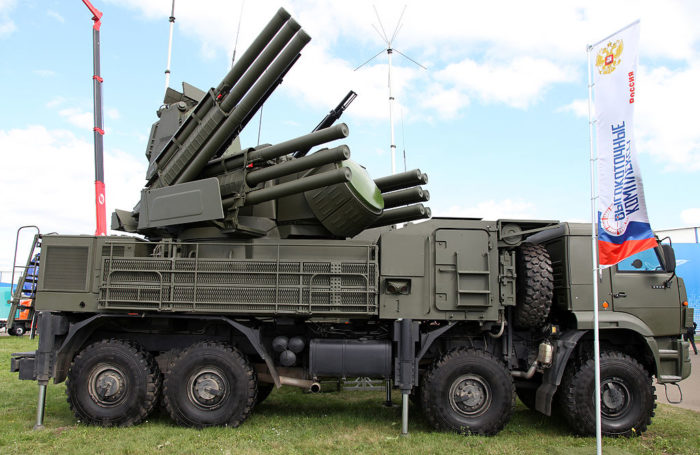Russian Pantsir system likely downed Azerbaijani airliner in Kazakhstan, say Defense Express analysts
The passenger Embraer 190 aircraft of Azerbaijan Airlines (AZAL), which crashed near Aktau, Kazakhstan, was likely downed by…


The passenger Embraer 190 aircraft of Azerbaijan Airlines (AZAL), which crashed near Aktau, Kazakhstan, was likely downed by a Russian Pantsir missile system operating in automatic mode, according to Defense Express.
The Embraer E190AR, with dozens of people on board, crashed on 25 December in Aktau, located in western Kazakhstan. Of the 67 people on board, 38 died. Other 29 people, including two children, were hospitalized, with 11 in serious but stable condition.
Initial photos and videos from the crash site made it clear that the bird strike theory was false. The footage shows clear signs of missile damage to the plane’s tail section, say Defense Express experts.
On that day, Russian air defenses were engaged in repelling a drone attack over Grozny, deploying the Pantsir missile system. However, experienced operators could not have confused a drone, light aircraft, and a large airliner with a 30-meter wingspan on their radar. Yet, Russian operators made this mistake. The report claims the Pantsir system may have been operating automatically.
In 2020, Russia boasted that the Pantsir system featured a fully automated mode. According to developers, the system incorporates artificial intelligence and can engage targets without human input.
Russian officials claimed that artificial intelligence is far more effective than human operators. However, in practice, it works on a simple algorithm—shoot down anything within its range without distinguishing between targets.
Despite civilian aircraft clearly signaling their status, Russian systems ignored these signals.
The “Tor” system also operates in automatic mode. It is likely that the Boeing 737 of Ukrainian airline MAU, flight PS752, which was downed over Tehran on 8 January 2020, was hit by a “Tor” system operating automatically.
The events surrounding the Azerbaijani flight 8243 appear to have reportedly unfolded as follows:
Near Grozny, the Embraer 190 was struck by the Pantsir system. The system operator, having switched it to automatic mode, received a command from their leaders, and all units were aware of the presence of a civilian aircraft in the airspace.
“In fact, the Russian military consciously gave permission to shoot down the passenger airliner. At 09:35 AM local time, the Azerbaijani Embraer 190 issued a distress signal. As a result of the strike, the aircraft’s control system was damaged, making it only partially controllable,” the report states.
Although there is no official record of conversations between the pilots and Russian air traffic controllers, the Azerbaijani plane was forced to fly across the Caspian Sea to Kazakhstan. The report suggests that Russian authorities may have wanted to “resolve the issue with the plane” outside Russian airspace, thus denying it permission to land in Grozny or nearby airports.
The crew managed to keep the damaged plane in the air for over 400 km, reaching Aktobe. The pilots’ efforts to save the passengers were considered miraculous, as 32 out of the 67 onboard survived despite the pilots losing their lives.
The possibility that the plane was shot down gained traction after videos of the wreckage emerged, showing clear signs of missile impacts. This theory was also supported by Andrii Kovaleko, head of the Center for Countering Disinformation at Ukraine’s National Security and Defense Council.
“Russia should have closed the airspace over Grozny, but it did not. The plane was damaged by the Russians and was sent to Kazakhstan instead of offering to make an emergency landing in Grozny to save lives,” Kovaleko stated.
Among the people on board, 42 were citizens of Azerbaijan, 16 of Russia, 6 of Kazakhstan, and 3 of Kyrgyzstan.
Related:
- Real justice for MH17 is Ukraine’s victory
- Drones target Chechnya, other north Caucasus regions in Russia (video)
- Ukraine targets Russian command center in Kursk Oblast, eliminates marine brigade commander
- “We need to see the Christmas star in the skies, not Iranian Shaheds or Russian missiles,” Zelenskyy says in holiday address (video)
You could close this page. Or you could join our community and help us produce more materials like this.
We keep our reporting open and accessible to everyone because we believe in the power of free information. This is why our small, cost-effective team depends on the support of readers like you to bring deliver timely news, quality analysis, and on-the-ground reports about Russia's war against Ukraine and Ukraine's struggle to build a democratic society.
A little bit goes a long way: for as little as the cost of one cup of coffee a month, you can help build bridges between Ukraine and the rest of the world, plus become a co-creator and vote for topics we should cover next. Become a patron or see other ways to support.



